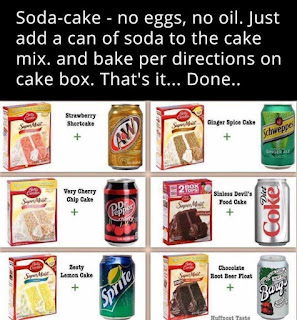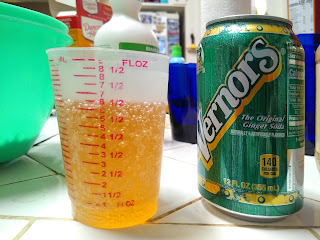Sometimes an idea gets dumped on me that sticks in my mind. I don't constantly think about it, but it will sit in the back of my mind and sporadically remind me of its existence, like a splinter that you can't decide is worth finding the tweezers over.
The pixelation of this image makes it look like it has made the reposting rounds a lot before someone semi-automatically forwarded it to me. It's got a HuffPost Taste watermark on it, but I suspect it started as a Betty Crocker advertisement. One will note that only Betty Crocker's cake mixes appear in the allegedly helpful infographic.
Anyway, I had to admit that this recipe got to me. Therefore, we're making the ginger spice version we see at top right. We didn't want a full 9x13 pan of cake mix reconstituted with soda, so we measured out half of the soda can. Halving the cake mix should have been trickier. If I wanted to be precise, I would have either poured all of the cake mix into a large measuring cup and then put half back in the box. Instead, I just eyeballed what looked like half of that synthetic-smelling powder and dumped soda on top.
One vigorous whisking later, we had a surprisingly convincing facsimile of cake batter. The taste of the ginger ale completely hid in the other spices. I expected perhaps a bit of extra pepperiness from the extra ginger, but it just tasted like spice cake. It seemed to retain a bit of fizziness even after an unnecessarily-thorough beating.
At first I thought a whole can of soda would make this batter ruinously runny. Previous experience strongly suggested that I would do nothing but waste the cake mix. But this time the batter at least looked fine, perhaps because the soda was the only liquid in the batter.
The resulting cake looked almost as thin as a pancake, but keep in mind that the initial cake batter barely coated the bottom of the pan. Manufacturers have long been shrinking cake mix boxes in that insidious a-snip-at-a-time way. Ten years ago, half a box of cake mix would have filled this pan without the aid of a rubber spatula to coax it to the edges.
The cake was a little spongy when we cut it, but it didn't seem unnervingly rubbery. Honestly, it appeared pretty normal.
I'm surprised to say this, but you get a perfectly normal cake out of a box of mix and a can of soda. I thought the cake's texture was just a little bit off, but others in
the house said it was perfectly fine. It's not the best cake I've ever
had, but it's not bad either. As you can see above, it's only thin because the batter started out so thin. What batter we had rose to a nice, fluffy height. The cake is a bit fragile and crumbly, so I would definitely just pour a glaze on top instead of icing it.
I can see how it'd be amusing to experiment with different combinations of cake mix flavors and different types of soda. Also, if you check the ingredients label on the cake mix, this could be a decent in-a-pinch vegan cake.
This got me to thinking: What is in cake mix that apparently allows you to reconstitute it into a reasonable approximation of cake with any liquid you can dump into it? I've never thought about the components of cake mix before. Like most of us, I've always thought of cake mix as a homogeneous compound that smells like artificial flavoring. I checked the ingredient label, and it's mostly flour, sugar, a bit of powdered milk, leavener, and a lot of other ingredients that I couldn't identify but I assume to be various flavorings, preservatives, and a few other things that presumably alter the texture. It looks more or less like the ingredients for a yellow cake if you left out the butter, milk, and eggs.
You probably already guess where this is going. We started with this yellow cake recipe from my friend's mother's Better Homes and Gardens Cookbook. It looks like the sort of thing that would have been made year after year for birthdays and various holidays, assuming you don't think you can substitute soda for butter and eggs. Anyone who actually followed all of the directions instead of going off-book before you've gotten halfway through the ingredient list would get a very nice cake. Unfortunately I am too daft for that.
We commenced, of course, by putting all the ingredients that are neither liquid nor perishable into a bowl.
I would like to say that it looked a lot like cake mix after a quick stir, but it didn't. The texture wasn't quite right. It didn't have that powdery-yet-gritty consistency of cake mix when you dump it out of the box.
By request of others, we are putting root beer into this attempted cake. The resulting batter tasted surprisingly acidic in a way that the cake-mix-based batter did not. The root beer tasted like it went from mildly tart to corrosive upon contact with flour.
I've never thought of root beer as particularly acidic. If anything, it tastes like fizzy vanilla to me. But this tasted less like cake batter and more like I should be scouring the floors with it instead of passing it off as edible. The "homemade" version of today's cake tasted more synthetic than the one that started with that mysterious powder loaded with natural and artificial flavors.
The resulting cake batter had the same color as the literal coffee cake we've made before. But unlike our various caffeinated cakes, this batter tasted terrible. Sometimes (usually) I deliberately do a lousy job of scraping the cake batter into the pan because it tastes too good not to eat. But this time, the batter was so weird I had to keep tasting it to see if it was as... unsubtly incorrect as I thought it was three seconds ago.
The batter looked totally normal going into the pan. But despite the harmless appearance, I suspected that I would be discreetly throwing this into the trash without letting anyone try it. I was getting comments from kitchen observers about how (barring a miracle in the oven) this was a waste of perfectly good root beer.
The resulting cake was oddly shiny on top, but otherwise it looked relatively acceptable.
If we examine the alleged cake in cross section, we see that it has managed to leaven itself. But it does look a bit... not right to anyone else? It looks less like a cake and more like a beige kitchen sponge.
After baking, the cake was still unnervingly acidic from the root beer. It had the same paste consistency as the Diet Coke cake, except this time it has air bubbles trapped in it. But you could knead it into a clay ball just like that time. While few cakes look good after you squish them in your fists, you should not be able to press a cake into a translucent ball like this:
This cake is of course not at all healthy, but it has that peculiar disappointment one gets from unrelentingly nutritious facsimiles of cakes and pies. You know, the hard cookies, carob brownies, and dusty pies that are infuriatingly close to the real thing but also flavorless and just wrong enough to go from mediocre to slightly depressing. This cake was so paste-like that I thought I had underbaked it. So, I put it back in the oven for so long that it should have hardened into one big crouton. This made no difference except to slightly dry the exposed edges.
We thought we might figure out what other little things we might add to correct the texture of this almost-viable cake, but then we all agreed that we would just be reverse-engineering a box of cake mix. It's easier and cheaper to just go out and buy one.
So, in conclusion, yes. You can pour a can of soda into a box of cake mix and get a decent cake. It's not the best cake you'll ever make, but it's not bad either. It's fun to make, and the results taste just fine albeit not all that great.
But you can't dump a can of soda into a previously normal cake recipe after leaving out the butter and eggs. If you're going to try a soda cake, you must embrace the box of prefabricated petrochemical magic. You should also use a smaller pan than you probably think.
 |
| Instead of closing today's (mis)adventure with disappointment, we're saying "au reservoir" with a photo of surprising success. |
















My favorite dump a can of something in a cake mix is a devil's food cake mix, a can of cherry pie filling, and 3 eggs. Bake at 350 for 30-35 min in a 9x13 pan.
ReplyDeleteI've seen that one done with brownie instead of cake mix. It was really good.
DeleteI think cake mixes might have some form of dry shortening incorporated into them, the way Bisquick does--but don't quote me on that. I definitely think yellow cake mixes include some form of butter flavoring, though. (My family used to have a bottle of artificial butter flavoring in the back of our spice cabinet for years... "Antique ingredients," as you once so succinctly said!)
ReplyDeleteThey might have. And... I've encountered artificial butter flavoring! A bottle of it turned up in the pantry once. It smelled like microwave popcorn.
Delete